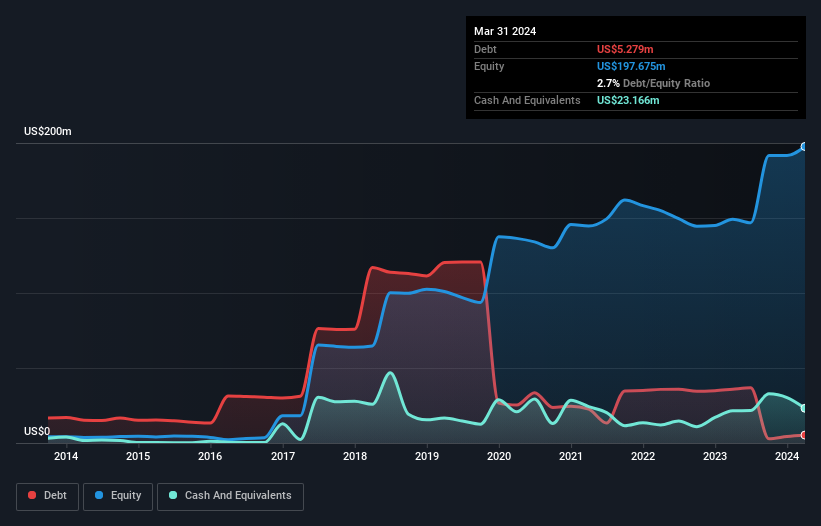- United States
- /
- Professional Services
- /
- NasdaqCM:ASUR
Is Asure Software (NASDAQ:ASUR) Using Too Much Debt?
David Iben put it well when he said, 'Volatility is not a risk we care about. What we care about is avoiding the permanent loss of capital.' It's only natural to consider a company's balance sheet when you examine how risky it is, since debt is often involved when a business collapses. We can see that Asure Software, Inc. (NASDAQ:ASUR) does use debt in its business. But the real question is whether this debt is making the company risky.
Why Does Debt Bring Risk?
Debt is a tool to help businesses grow, but if a business is incapable of paying off its lenders, then it exists at their mercy. In the worst case scenario, a company can go bankrupt if it cannot pay its creditors. However, a more common (but still painful) scenario is that it has to raise new equity capital at a low price, thus permanently diluting shareholders. Having said that, the most common situation is where a company manages its debt reasonably well - and to its own advantage. When we think about a company's use of debt, we first look at cash and debt together.
View our latest analysis for Asure Software
What Is Asure Software's Net Debt?
You can click the graphic below for the historical numbers, but it shows that Asure Software had US$5.28m of debt in March 2024, down from US$35.9m, one year before. But it also has US$23.2m in cash to offset that, meaning it has US$17.9m net cash.

How Healthy Is Asure Software's Balance Sheet?
We can see from the most recent balance sheet that Asure Software had liabilities of US$258.4m falling due within a year, and liabilities of US$13.3m due beyond that. On the other hand, it had cash of US$23.2m and US$15.1m worth of receivables due within a year. So its liabilities outweigh the sum of its cash and (near-term) receivables by US$233.4m.
Given this deficit is actually higher than the company's market capitalization of US$230.0m, we think shareholders really should watch Asure Software's debt levels, like a parent watching their child ride a bike for the first time. Hypothetically, extremely heavy dilution would be required if the company were forced to pay down its liabilities by raising capital at the current share price. Given that Asure Software has more cash than debt, we're pretty confident it can handle its debt, despite the fact that it has a lot of liabilities in total. The balance sheet is clearly the area to focus on when you are analysing debt. But it is future earnings, more than anything, that will determine Asure Software's ability to maintain a healthy balance sheet going forward. So if you want to see what the professionals think, you might find this free report on analyst profit forecasts to be interesting.
In the last year Asure Software wasn't profitable at an EBIT level, but managed to grow its revenue by 13%, to US$118m. We usually like to see faster growth from unprofitable companies, but each to their own.
So How Risky Is Asure Software?
We have no doubt that loss making companies are, in general, riskier than profitable ones. And we do note that Asure Software had an earnings before interest and tax (EBIT) loss, over the last year. Indeed, in that time it burnt through US$7.4m of cash and made a loss of US$9.9m. But the saving grace is the US$17.9m on the balance sheet. That kitty means the company can keep spending for growth for at least two years, at current rates. Summing up, we're a little skeptical of this one, as it seems fairly risky in the absence of free cashflow. There's no doubt that we learn most about debt from the balance sheet. But ultimately, every company can contain risks that exist outside of the balance sheet. Be aware that Asure Software is showing 2 warning signs in our investment analysis , you should know about...
When all is said and done, sometimes its easier to focus on companies that don't even need debt. Readers can access a list of growth stocks with zero net debt 100% free, right now.
New: Manage All Your Stock Portfolios in One Place
We've created the ultimate portfolio companion for stock investors, and it's free.
• Connect an unlimited number of Portfolios and see your total in one currency
• Be alerted to new Warning Signs or Risks via email or mobile
• Track the Fair Value of your stocks
Have feedback on this article? Concerned about the content? Get in touch with us directly. Alternatively, email editorial-team (at) simplywallst.com.
This article by Simply Wall St is general in nature. We provide commentary based on historical data and analyst forecasts only using an unbiased methodology and our articles are not intended to be financial advice. It does not constitute a recommendation to buy or sell any stock, and does not take account of your objectives, or your financial situation. We aim to bring you long-term focused analysis driven by fundamental data. Note that our analysis may not factor in the latest price-sensitive company announcements or qualitative material. Simply Wall St has no position in any stocks mentioned.
Have feedback on this article? Concerned about the content? Get in touch with us directly. Alternatively, email editorial-team@simplywallst.com
About NasdaqCM:ASUR
Asure Software
Engages in the provision of cloud-based Human Capital Management (HCM) software solutions in the United States.
Reasonable growth potential with adequate balance sheet.
Similar Companies
Market Insights
Community Narratives



